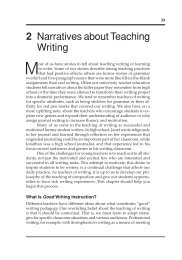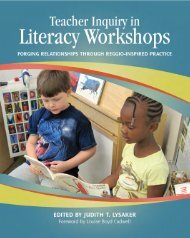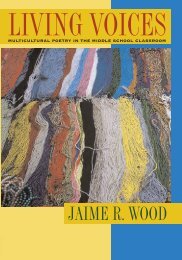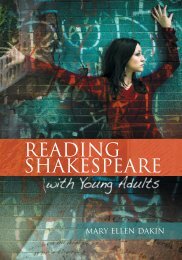Graphic novel Spread - National Council of Teachers of English
Graphic novel Spread - National Council of Teachers of English
Graphic novel Spread - National Council of Teachers of English
- No tags were found...
You also want an ePaper? Increase the reach of your titles
YUMPU automatically turns print PDFs into web optimized ePapers that Google loves.
8 James Bucky Carter<br />
cultural literacy, the idea that there are certain things that everyone<br />
should know to be considered educated, competent citizens<br />
(e.g., E. D. Hirsch)<br />
progressive literacy, a constructivist approach to creating highly<br />
individualistic notions <strong>of</strong> what learning and living entail<br />
critical literacy, a postmodern (Meacham & Buendia, 1999), radical<br />
notion that can be defined as “a literacy <strong>of</strong> social transformation<br />
in which the ideological foundations <strong>of</strong> knowledge,<br />
culture, schooling, and identity-making are recognized as unavoidably<br />
political” and in which students engage critically in<br />
reading “the world and the word, by using dialogue to engage<br />
texts and discourses inside and outside the classroom” (p. 377).<br />
Critical literacy is favored by Cadiero-Kaplan herself and is prominent<br />
in the work <strong>of</strong> Stanley Aronowitz, Henry Giroux and, most notably,<br />
Paulo Freire.<br />
Gretchen E. Schwarz tackles this graphic <strong>novel</strong>-literacy connection<br />
directly in her article “<strong>Graphic</strong> Novels for Multiple Literacies”<br />
(2002). Hearkening to the ideals <strong>of</strong> critical and visual literacy, she explains<br />
that “in an increasingly visual culture, literacy educators can<br />
pr<strong>of</strong>it from the use <strong>of</strong> graphic <strong>novel</strong>s in the classroom, especially for<br />
young adults” (2002, p. 1). Not only do graphic <strong>novel</strong>s promote literacy<br />
(Lavin, 1998; Weiner, 2002), but they “<strong>of</strong>fer value, variety, and a new<br />
medium for literacy that acknowledges the impact <strong>of</strong> visuals” (p. 1).<br />
Furthermore, Schwarz asserts that “An important benefit <strong>of</strong> graphic<br />
<strong>novel</strong>s is that they present alternative views <strong>of</strong> culture, history and human<br />
life in general in accessible ways” (p. 3), tying the graphic <strong>novel</strong> to<br />
progressive, cultural, and critical notions <strong>of</strong> literacy. With respect to<br />
functional literacy, Schwarz suggests that graphic <strong>novel</strong>s can be used<br />
for teaching literary terms and techniques and that social studies is a<br />
curricular area in which they are particularly strong and can easily be<br />
used across-the-curriculum: “graphic <strong>novel</strong>s can bring new life beyond<br />
bland textbooks” (p. 2). Indeed, many graphic <strong>novel</strong>s that are considered<br />
at the top <strong>of</strong> their format deal with political and social issues.<br />
Although Schwarz (2002) gives no concrete examples (the present<br />
collection <strong>of</strong> essays seeks to remedy this problem), she explains that she<br />
is aware <strong>of</strong> some <strong>English</strong> teachers who make use <strong>of</strong> graphic <strong>novel</strong>s in<br />
their classes and further persuades her readership <strong>of</strong> their worth by citing<br />
graphic <strong>novel</strong>s developed specifically for aiding academics, such as<br />
“McLuhan for Beginners (Gordon & Willmarth, 1997) and Introducing<br />
Cultural Studies (Sardar & Van Loon, 1998)” (p. 2). Indeed, <strong>National</strong><br />
Public Radio has recently brought the graphic <strong>novel</strong> Dignifying Science<br />
back into the national spotlight by featuring a broadcast on the work’s
















